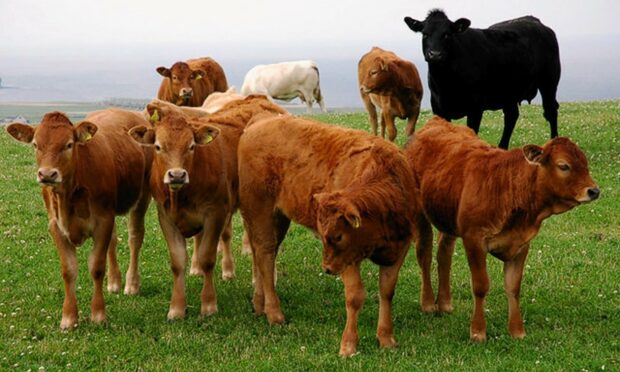Industry leaders have joined forces to encourage farmers and crofters to sign up to the new Beef Efficiency Scheme (BES).
Representatives from NFU Scotland, the Scottish Beef Association, government, the Scottish Association of Meat Wholesalers, SRUC, Quality Meat Scotland, agri co-op body SAOS and the Beef 2020 group met earlier this week and agreed to work together to make the scheme a success.
The scheme, which is worth around £45million over three years, aims to improve the efficiency, sustainability and quality of the Scottish beef herd.
It also sets out to improve genetics on Scottish farms and reduce the greenhouse gas emissions caused by beef production.
Applications for the scheme must be submitted by May 31 and it is estimated farmers who qualify for support will be paid around £32 per calf for three years, however the scheme will run for five years. It will be hosted on the ScotEID website.
Following a meeting of industry bodies and government earlier this week, more details have emerged surrounding the scheme and what farmers will be required to do in order to get support.
NFU Scotland’s livestock committee chairman, Charlie Adam, said: “There are many merits to the aims of the scheme and much of what farmers are asked to do will benefit their business. In these difficult times, most producers are looking very hard at the bottom line and through BES, a typical herd of 75 cows will get access to an estimated £7,000 thanks to the scheme. In these cash-strapped times, very few businesses can afford to let the opportunity of an additional funding stream pass.
“Although payment is proposed for the first three years of the scheme, the union will keep pushing for farmers to be paid for the full five-year term.”
Scott Henderson, of the Scottish Beef Association, said he was fully behind the aims of the scheme and encouraged all eligible producers to sign up.
He said: “Although a five-year scheme, and funding is only guaranteed for the first three, the efficiency gains generated by management changes throughout its course should deliver benefits back to the bottom line of the business long before the money runs out.
“For every extra calf that you sell, it will add directly to your profit with, in many cases, no extra costs and the same can be said for every kilo extra of liveweight gain your cattle achieve.”
What does the scheme entail?
Producers will need to make use of advisory services – this means watching an online video in year one and attending three local group meetings and a single one-to-one meeting during the course of the scheme.
Farmers will need to identify and commence three management changes, with the assistance of the advisory services, and monitor these changes over the course of the scheme.
To participate in the scheme, all calves registered will need to be weighed at some point between 120 and 400 days old. The exact rules are yet to be finalised by the European Commission.
Batch weights at markets will be permitted provided the calves are of similar size, and the individual weights must be recorded on the BES system.
The reference year for all scheme applicants, with the exception of new entrants and young farmers, is the 2015 year calf crop and 20% of those calves will need to have tissue samples taken to form a reference population.
Tissue tags will be sent to the farmer as close as possible to weaning time with a list of what calves have been selected to be sampled.
A carbon audit will also be required and farmers will be asked to submit information about normal day-to-day business operations such as fuel, fertiliser, feed and electricity use.
The scheme’s advisory service will provide information on how to complete the audit and farmers will not be penalised for mistakes in the only. Those who fail to complete the audit will be penalised.
Other penalties will only be applied if producers reduce their herd size to a level where they cannot provide enough calves for tissue tagging. For example, if you had 47 reference animals in 2015 then you must have at least nine eligible calves in 2016.
Lastly farmers who sign up to the scheme will have the option to leave without paying a penalty provided they exit the scheme within the first year and before the first batch of payments in May 2017.










